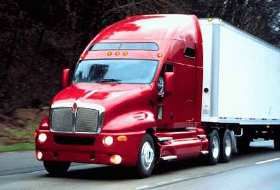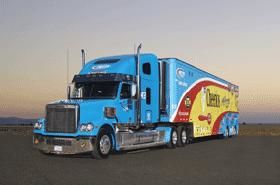TransAm Made Me A First Seat Driver! It's Been A Long Road
Topic 9230 | Page 2

This is something i worry about too. I havent even gotten hired anywhere yet but i worry about what its going to be like when i start solo. I havent really driven anywhere outside the northeast so i figure ill be fine but ive heard too many stories about Qualcomm being wrong and gps being wrong where i wonder how im ever gonna figure out where im going after i leave the interstate.
The suggested route stuff on the QUALCOMM needs a grain of salt. But the request directions is made by other drivers and seems to be pretty accurate from what I've seen so far.
The GPS address and google maps address differ sometimes. But with google maps you can get a satellite view to show where the trucks are parking and that helps a lot. Look for gate entrances and shadows of gates and fences. You need to find the shipping and receiving entrance. After you find the right building of course. Some places are in industrial complexes. This means that a lot of companies are in the same GPS address and have only a different building number. And some companies share the same building. Along with some companies have a different name on the building than the one you're looking for. Those are just most fun. It's kind of like hide and seek while using a semi-truck to get around. Oh wait, it is.
Oh and the GPS REALLY needs updating. It doesn't always account for extra-wide freeways. It sometimes will think you are on some feeder road or some other and try to direct you someplace that you have no business going. Just to put you back on the road you are already on. Also, exits move in real life some. The GPS doesn't know about the new exit locations. If it says take exit 17 to bla-bla, and you see exit 17 coming up but GPS says it's still a mile away... You are about to pass your exit.
The best way to to follow the GPS is listen to what it says, "Slide right onto I-78 West..." Then you look for signs that tell you what lane to be in for I-78 west and forget about looking at the GPS for distance to turns and so forth. You can then concentrate on the road and traffic. Get into the proper lane that the sign says to be in and you are all good to go. The GPS gives clues, but it's not the gospel.
Anyway, that's my 2 cents.
Qualcomm:
Omnitracs (a.k.a. Qualcomm) is a satellite-based messaging system with built-in GPS capabilities built by Qualcomm. It has a small computer screen and keyboard and is tied into the truck’s computer. It allows trucking companies to track where the driver is at, monitor the truck, and send and receive messages with the driver – similar to email.Interstate:
Commercial trade, business, movement of goods or money, or transportation from one state to another, regulated by the Federal Department Of Transportation (DOT).
HOS:
Hours Of Service
HOS refers to the logbook hours of service regulations.
Sometimes that works but in poorly lit or even dark areas, you may need some idea of distance to your turn.
New Reply:
New! Check out our help videos for a better understanding of our forum features

















Preview:








 TT On Facebook
TT On Facebook
I did worry about this too. I'm thanking the trucking gods that this actually happened during time with my second trainer. We got turned around by a poorly marked road closed sign in rural Ohio and found ourselves lost and on roads not designed to accommodate an 18 wheeler. The road closed sign was on the shoulder and not even in a place that impeded traffic. I over thought this one.
The Qualcomm lost both satellite and 3G cell signals. We were flying blind and trainer was nervous. I actually remained calm and rational. I knew the general direction we wanted to go was west. All I had to do was be mindful of a low bridge or bridge with a 3-5 ton weight limit. At one point we got down a road so narrow it was impossible to turn around and a 3 ton bridge came up. Turning around risked a rollover and crossing risked a collapsed bridge. The other option was to drive in reverse nearly ten miles and more serious risk. Clearly a catch 22. So I put my 4 ways on and paced out the length of the bridge. Turns out that the bridge was a little over the length of a pickup truck and 10 ft wide. Safest course of action .... cross the bridge. So at least the bridge would get a rest break between the steers, drives, and trailer tandems.
Again, luck was on our side because the bridge held fast! Lesson learned. It's best to treat a road closed sign, even one well off to the side and not even impeding as the gospel truth. Other truckers fell for this too so when we were finally back on main roads, we got on the CB and advised others.
Tandems:
Tandem Axles
A set of axles spaced close together, legally defined as more than 40 and less than 96 inches apart by the USDOT. Drivers tend to refer to the tandem axles on their trailer as just "tandems". You might hear a driver say, "I'm 400 pounds overweight on my tandems", referring to his trailer tandems, not his tractor tandems. Tractor tandems are generally just referred to as "drives" which is short for "drive axles".
Tandem:
Tandem Axles
A set of axles spaced close together, legally defined as more than 40 and less than 96 inches apart by the USDOT. Drivers tend to refer to the tandem axles on their trailer as just "tandems". You might hear a driver say, "I'm 400 pounds overweight on my tandems", referring to his trailer tandems, not his tractor tandems. Tractor tandems are generally just referred to as "drives" which is short for "drive axles".
Qualcomm:
Omnitracs (a.k.a. Qualcomm) is a satellite-based messaging system with built-in GPS capabilities built by Qualcomm. It has a small computer screen and keyboard and is tied into the truck’s computer. It allows trucking companies to track where the driver is at, monitor the truck, and send and receive messages with the driver – similar to email.Interstate:
Commercial trade, business, movement of goods or money, or transportation from one state to another, regulated by the Federal Department Of Transportation (DOT).